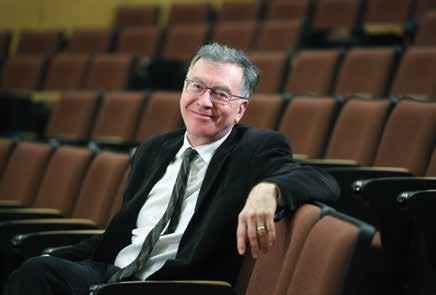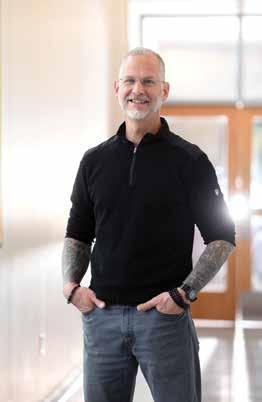
14 minute read
DAL Magazine Spring/Summer 2019

More Than Code
Advertisement
By Genevieve MacIntyre
Illustration by Julia Breckenreid
The phrase “Artificial Intelligence” conjures images of computer coders and vast networks of software and hardware. But AI has implications that stretch into the humanities as well, many of them being explored by researchers in Dalhousie’s Faculty of Arts and Social Sciences.
Artificial Intelligence (AI) is a field rich with engineers, computer scientists and information technologists. But AI isn’t just about technology. The philosophical and moral decisions that underpin our approach to AI’s development and its applications in fields as diverse as music, language, health and security are as critical to conversations about this rapidly growing field as the nuts, bolts and software built into a computer program or machine. It’s an expanding field with complex cultural and social impacts that cannot and should not be ignored. Scholars in Dalhousie’s Faculty of Arts and Social Sciences (fass) are engaged in important research on the role of artificial intelligence and related technologies. Professors in fass are preparing students for a future in this field and imparting the tools they will need to understand and navigate a rapidly changing society, including in a new Certificate in Computing in Arts and Social Sciences, designed for students in the arts, social sciences and humanities. The program is intended to expand participants’ digital literacy, allowing students to develop and apply technical computing skills while exploring key social and intellectual issues. As Howard Ramos, professor in the department of Sociology and Social Anthropology and associate dean of research for fass notes, “fass is lucky to have a wide range of researchers working in this field, and it’s exciting to see how important arts and social sciences are for navigating changing technology.” Here are some of the FASS faculty members exploring this critical field.
Research project:
Exploring the ethics of using AI to control autonomous lethal weapons
Are there times when it is morally right to put artificial intelligence in charge of lethal weapons? Some researchers suggest that only humans should make life and death decisions—but Duncan MacIntosh of Dalhousie’s Department of Philosophy disagrees. “What matters is not that lethality be under the control of humans,” Dr. MacIntosh explains, “but that it be under the control of morality. And there are many situations where we are more likely to see a morally good outcome when machines are making these decisions.”
He suggests these decisions should be made by whatever would result in the morally best outcomes. Dr. MacIntosh’s research generally explores what outcomes would emerge if we only insert AI machines with the right competence in the right scenario that would not jeopardize the situation with an immoral outcome. These situations include when there would be excessive dangers to human decision-makers in the decision environment (such as from radiation, poison gas, bullets or blast, so that it would be immoral to put humans in that situation); when a human making the decision would likely experience extreme psychological trauma and inappropriate levels of guilt, and so a machine-made decision would spare the conscience of a human; and when a lethal action should be performed, but its performance is beneath the dignity of a human, so that a human shouldn’t have to perform it.
Dr. MacIntosh sits on the executive board of the Center for Ethics and the Rule of Law (cerl) at the University of Pennsylvania Law School. His work echoes the center’s belief that real-world practitioners in government, national security, intelligence, the military and business need academics to help them process issues of the moment, and that academics need practitioners to help ground their theories in the world and to make them matter. His work with cerl has included explorations of the causes and cures of conflict, how to respond to foreign interference with democratic institutions, the protection of cultural artifacts in time of war, and whether outer space should be militarized.
Dr. MacIntosh’s research also explores the argument that AI machines are unlikely to be able to be designed with the levels of moral intelligence and social awareness required to effectively make morally correct life-and-death decisions. For example, can we design machines able to detect people’s attempts to surrender? Dr. MacIntosh believes that we can correct this by carefully deploying AI machines only in contexts where their competences are likely to have morally good outcomes.
“Morality is stratified in this way, and the responsible use of AI only requires us to insert machines with the right competence in the right strata,” says Dr. MacIntosh. “We don’t need to have a morally omniscient intelligence in charge of a given decision. We only need something intelligent enough to be in charge of some limited effect in some limited purview. And we shouldn’t deploy a machine in a given context until we know it is unlikely to make a moral mistake in that context.”

Dr. Duncan MacIntosh advises on the moral questions around AI's use in weapon Control.
Artificial intelligence (AI) is the science and engineering of making machines, especially computer programs, that are capable of tasks and processes usually associated with human or animal intelligence. These tasks include visual perception, decision-making, translation between languages or speech recognition; the processes include learning, reasoning and self-correction. Machine learning is an approach to AI that involves teaching machines how to solve problems by processing examples of human intelligence. Through machine learning, problems that were intractable for AI are now being solved.
Teaching computers to read medieval music
Imagine that you are a music historian, searching for a particular piece of medieval music. In the past, this might have involved trips to specialized libraries, some of them a continent away. Or perhaps you would be able to arrange for a library to send a manuscript via post (as they did in Europe in the nineteenth and early twentieth centuries)— potentially risky should the manuscript go astray, and even when feasible, could take months. Once you had the manuscript, hours would be spent analyzing it, deciphering notations written by hand, often on material that had suffered physical deterioration over time. But what if AI could make that process simpler?
That’s what Dalhousie musicologist Jennifer Bain and a team comprised of computer scientists and musicologists from the U.S., Germany and Portugal, as well as from other universities in Canada including Western, McGill and Waterloo, hope to achieve. They are working together to produce online digital tools for analyzing early musical sources through a project centred at McGill University called Cantus Ultimus, one arm of a larger undertaking called the Single Interface for Music Score Searching and Analysis (simssa). The Cantus Ultimus site allows researchers, choir directors and musicians from around the world to remotely access and search medieval music manuscripts for musical content alongside catalogues and metadata from the digital Cantus Database (a database of the Latin chants found in over 140 manuscripts and early printed books).
One of SIMMSA'S aims is to provide optical music recognition software to search for musical content in any kind of digitized document. It’s similar to the optical character recognition software which reads digital content such as in Google Books or the banking apps that read the numbers on your cheque to facilitate electronic deposit. The researchers are using a system capable of encoding—or describing—music notation structures to allow musical content to be analyzed and searched in a standardized way. Part of their project is to develop a module for musical encoding specifically targeted at medieval neume notations. (A neume is a note or group of notes sung as one syllable.)
How does AI enter into this effort? Teaching a computer how to read medieval musical notation is complex. Dr. Bain leads the team of musicologists and more than a dozen student researchers who have manually transcribed thousands of melodies so a machine can read a melody and compare it with the manual transcription. They can then identify where the machine is going wrong and target those areas and correct them—teaching the computer how to read music so they can then use the computer to search for music. Once Dr. Bain’s musicology team has done their work, the computer scientists on the project team develop and refine the software required to correct errors and feed them back to the computer so that it can “learn.” Fundamentally, the process is one of pattern recognition or machine reading, a branch of AI in which a computer learns how to decode something.
“The Cantus Ultimus and simssa projects are important because they are providing tools to help us better understand the first few hundred years of notated music produced in the Western world,” says Dr. Bain. “The groundwork we’ve established we will now build on in our new project, the Digital Analysis of Chant Transmission, in which we will trace the movement of liturgical plainchant from Europe to other parts of the world through colonialism and assess its dissemination and impact.”

Dr. Jennifer Bain’s team is teaching the computer to read medieval musical notations so that they can then use it to search for music.
Research project:
Investigating machines’ ability to capture human natural language skills
Read this phrase: “Since it was raining, I carried the newspaper over my backpack to keep it dry.” What was kept dry? You probably said, “the backpack,” because that makes the most sense in context—but grammatically, “it” could also have been the newspaper. Most people can infer the correct response based on syntactic disambiguation: considering the word “it” in the phrase, and figuring out which word “it” refers to.
Some people in Philosophy say that no machine can ever answer these types of questions as well as a person, because the person has the benefit of a lifetime of embodied experience with the human world—and machines don’t have that. “[My computer] doesn’t have a body and it hasn’t lived a life,” explains Darren Abramson of Dalhousie’s Department of Philosophy. “When I read these phrases, it seems like I have to really think about experiences that I’ve had, and it’s those experiences that we think about in our own case that helps us to disambiguate these statements.”
For at least 60 years, philosophers, linguists and psychologists have noticed examples like these and claimed that even short, simple sentences of English and other languages cannot be syntactically disambiguated without normal human knowledge of the world and the meanings of words.
“I’m skeptical of these claims,” says Dr. Abramson. “My research has for my entire career defended the view that machines can think.”
Dr. Abramson’s research project empirically investigates the adequacy of language models built using machine learning for capturing such human natural language abilities. There are well-defined benchmarks, such as the Winograd schema challenge (designed to judge whether a computer program has truly modeled human level intelligence), that serve as intermediate goals to building a machine that can pass the Turing test—developed by Alan Turing in 1950 to test a machine’s ability to exhibit intelligent behavior equivalent to, or indistinguishable from, that of a human.
“My interest in this research area has to do with an old idea called mind design: we improve our understanding of the human mind by attempting to build artificial ones. The tools I’m using are unique in that researchers in AI freely distribute both the tools and their improvements to them, along with an unusual commitment to reproducibility in research.”
Dr. Abramson explains that with research internships funded by the Mitacs Globalink project, and supported by graphics processing unit time granted by Compute Canada, he is now moving from evaluating models produced by the research community to constructing new models. “My overall research goal is to help advance machine learning to a solution to the challenge, while encouraging members of the philosophy community to understand the significance of recent developments in machine learning.”
His knowledge of computer applications and programming is rooted in the time he spent at Indiana University, where he completed his PhD in Philosophy and Cognitive Science. While there, he concurrently completed his MSc in Computer Science—without having an undergraduate degree in Science or Computer Science.
“I strongly believe that arts students and faculty have everything to gain by viewing computer programming as something they can do,” says Dr. Abramson. “I’m a really big believer in universal computer programming ability. And I'd very much like to see our students think of computer programming as just one skill—in the same way that every arts student should know a little bit of calculus, history, maybe have a second language, they should also have some programming skills.”
Dr. Abramson’s research also explores insights from the humanities on what uniquely human capacities we should try to get machines to be better at. “Where are you going to go for insights about human capacities?” he asks. “The Arts and Social Sciences Faculty.”

"I strongly believe that arts students and faculty have everything to gain by viewing computer programming as something they can do," says Darren Abramson Associate Professor, Department of Philosophy.
Virtual reality: Putting Participants in the Potala Palace with the Dalai lama
When you think of the sociology of religion, you probably don’t think of virtual reality and video games. But it’s an area of study that Dalhousie Sociology Professor Chris Helland is a pioneer in researching. He wrote one of the first PhDs on religion and the internet and developed the system of classification for studying this area of sociology.

Dr. Chris Helland is using VR to allow people to experience being in the virtual presence of the Dalai Lama.
“Around the year 2000, because of the limits of technology, there was some online ritual, but there wasn’t a lot,” Dr. Helland, who has studied online rituals for almost 20 years, explains. “So it was very rare, but it would happen and it was beautiful and fascinating to see how people were shaping computer technology so it could meet their social needs.”
Dr. Helland, who is a practitioner of Tibetan Buddhism, recently received Social Sciences and Humanities Research Council grant funding for his research on a large virtual project with the Dalai Lama. Called the Virtual Tibet Project, it involves working with Silverback Interactive, a Halifax company that makes games and powerful virtual and augmented reality training systems, and with Oculus, a company that specializes in virtual reality hardware and software products, to create a virtual reality (VR) experience where users can have a close encounter with the Dalai Lama in Tibet. Where artificial intelligence is the science and engineering of making intelligent machines and computer programs, virtual reality is a computer-generated simulation of a three-dimensional image or environment, allowing the user to interact with simulated artificial worlds.
Using old photographs, documents and books, the research team has created a 3D VR experience with the Dalai Lama in the Potala Palace in Tibet (his residence until he fled to India during the 1959 conflict). The team has created this world based on their collected research, right down to the wood grains on the floor. “It’s beyond what you can imagine,” says Dr. Helland. “It’s incredible.”
For users of this VR experience to visit the Potala Palace, where the Dalai Lama himself hasn’t been permitted to return since 1959, is significant because this is his traditional seat of power and where he historically would have conducted rituals. The team is recording statements that the Dalai Lama would say and mapping them to his face using computer generated imagery, so that the user experiences being spoken directly to by the Dalai Lama. The user can also experience traveling through northern India and the Tibetan territory, exploring the Potala Palace, the Himalayas and Mount Everest, as well as being greeted by the Dalai Lama and witnessing him perform the ritual of the Chenrezig empowerment initiation, where he transforms to the Buddha of Compassion.
Dr. Helland says that this VR experience will interest many people, including gamers, people in the tech industry, those interested in religious rituals, Tibetan Buddhists and people who are simply curious. He has been invited to the Smithsonian Institute in Washington to present on the project.
“The Dalai Lama is getting older,” explains Dr. Helland. “It’s harder for him to travel. But he’s so popular and so many people love him. And the desire for people to be close to him, to meet him and to see him is huge. We can use VR technology to meet those needs, so that people feel that they have an intimate encounter with him. And based on the feedback we’ve been getting, it’s a powerful experience.”

